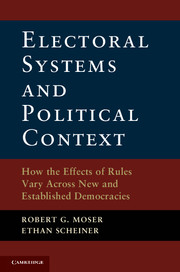 Electoral Systems and Political Context
Electoral Systems and Political Context Book contents
- Frontmatter
- Contents
- Tables and Figures
- Abbreviations
- Glossary of Key Terms
- Acknowledgments and Note on the Online Appendix
- Introduction
- 1 When Do the Effects of Electoral Systems Diverge from Our Expectations?
- 2 Mixed-Member Electoral Systems
- 3 How Democratic Experience and Party System Development Condition the Effects of Electoral Rules on Disproportionality and the Number of Parties
- 4 How Democratic Experience and Party System Development Condition the Effects of Electoral Rules on Disproportionality and the Number of Parties
- 5 Political Context, Electoral Rules, and Their Effects on Strategic and Personal Voting
- 6 How Democratic Experience and Party System Development Condition the Effect of Electoral Rules on Strategic Defection
- 7 Social Diversity, Electoral Rules, and the Number of Parties
- 8 How Political Context Shapes the Effect of Electoral Rules on Women's Representation
- 9 Conclusion
- References
- Index
2 - Mixed-Member Electoral Systems
How They Work and How They Work for Scholars
Published online by Cambridge University Press: 05 November 2012
- Frontmatter
- Contents
- Tables and Figures
- Abbreviations
- Glossary of Key Terms
- Acknowledgments and Note on the Online Appendix
- Introduction
- 1 When Do the Effects of Electoral Systems Diverge from Our Expectations?
- 2 Mixed-Member Electoral Systems
- 3 How Democratic Experience and Party System Development Condition the Effects of Electoral Rules on Disproportionality and the Number of Parties
- 4 How Democratic Experience and Party System Development Condition the Effects of Electoral Rules on Disproportionality and the Number of Parties
- 5 Political Context, Electoral Rules, and Their Effects on Strategic and Personal Voting
- 6 How Democratic Experience and Party System Development Condition the Effect of Electoral Rules on Strategic Defection
- 7 Social Diversity, Electoral Rules, and the Number of Parties
- 8 How Political Context Shapes the Effect of Electoral Rules on Women's Representation
- 9 Conclusion
- References
- Index
Summary
In Chapter 1, we suggested a number of ways that we believe electoral rules may affect politics while also being conditioned by other factors. In this chapter, we discuss how studying mixed-member electoral systems with an approach that Arend Lijphart labeled “controlled comparison” can help us investigate these electoral rule effects.
In the first part of this chapter, we describe the basic workings of “two-vote” mixed-member systems and explain how these systems make the controlled comparison approach possible. We highlight how this approach to the study of mixed-member systems offers a number of advantages in studying the differing effects of SMD and PR electoral rules. In the second part of the chapter, we discuss “contamination” between the PR and SMD tiers – the chief misgiving offered by critics of the controlled comparison approach to studying mixed-member systems – and explain why we believe that contamination does not cause significant problems for the analysis in this book. In the third and final part of the chapter, we describe the defining characteristics of mixed-member systems, outline the major variations found within this classification of electoral system, and discuss how these variations may have important consequences of their own.
- Type
- Chapter
- Information
- Electoral Systems and Political ContextHow the Effects of Rules Vary Across New and Established Democracies, pp. 42 - 69Publisher: Cambridge University PressPrint publication year: 2012


